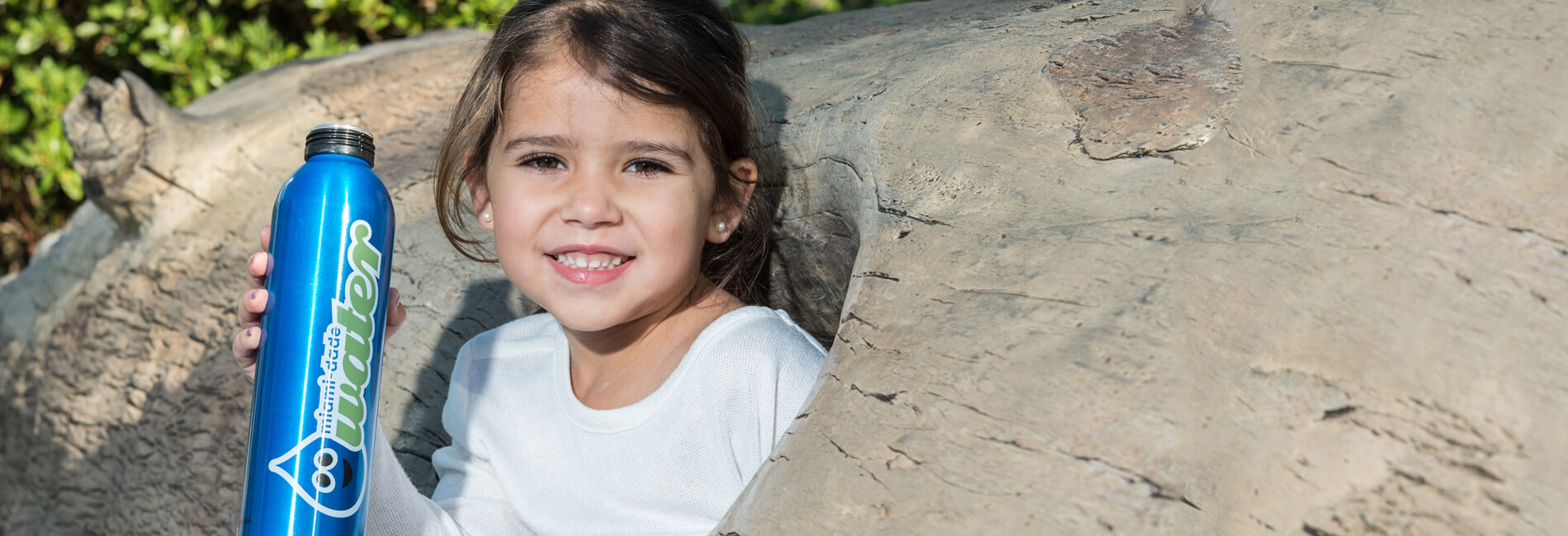The Biscayne Aquifer is located just below ground level. Comprised of porous rock, rain water seeps in and fills tiny cracks and holes.
This water is often referred to as groundwater or the water table, and provides most of the drinking water used by South Florida residents, visitors and businesses. This water is generally clean because of a natural filtration process.
The water flows like an underground river at a very slow rate. It travels in an east-southeasterly direction at a rate of two feet per day. However, where there are very large openings or man-made canals the flow rate can increase substantially. Because this drinking water supply is so close to the surface (barely a few feet down in most places), it is especially susceptible to contamination.
That’s why Miami-Dade County, in cooperation with other local, state and federal agencies, works to safeguard the supply source for drinking water. This may result in environmental regulations for businesses in the South Florida area being more stringent than other areas of the country, but it is necessary to protect the health of everyone dependent on clean water.
The establishment of proactive safeguards can also prevent expensive water treatment processes at our water treatment plants.
The water on Earth is continuously circulating between the air or atmosphere, the land and the sea. The ways in which water moves around, above, on and within the Earth is the hydrologic or water cycle.
The sun is the energy source for the water cycle, causing water to evaporate from lakes, rivers and oceans, as well as from land surfaces and vegetation. When water evaporates, it changes to a gas (water vapor) and rises in the air. When the water vapor rises and meets cold air, it condenses, forming water droplets, or what we see as clouds or fog. This process is called condensation. Water droplets combine into water drops and return to the Earth as precipitation in the form of rain, sleet, hail or snow.
Some rain is absorbed by vegetation or evaporates before it reaches the ground. Some evaporates after it reaches the surface. Some soaks into the ground into the Biscayne Aquifer and is taken up by the roots of plants and then released back into the air through the leaves of the plants in a process called transpiration. The combination of evaporation and transpiration is referred to as evapotranspiration. Some rain percolates into underground units of water-bearing rock called water table aquifers. The remainder becomes surface or stormwater runoff that flows over the ground to wetlands, lakes, ponds, rivers and oceans.
A water molecule's trip from the atmosphere and back may be very long or very short. It may stay in the atmosphere for only a few days or it may remain deeply buried in cavities in the earth or frozen in polar ice caps for thousands of years.
Approximately 330 million gallons per day (mgd) are withdrawn from the Biscayne Aquifer through wells extending an average of 80 feet below the ground’s surface to meet the needs of the community.
As water travels over the surface of the land or through the ground, it dissolves naturally occurring minerals and can pick up substances resulting from the presence of animals or from human activity. To ensure that Miami-Dade water is safe to drink, WASD adheres to and, in many cases surpasses, U.S. Environmental Protection Agency (EPA) regulations regarding the contaminants in water provided by public water systems.
Highly trained microbiologists, chemists and water treatment specialists conduct or supervise more than 320,000 analyses of water samples each year. Water quality samples are collected throughout the county and tested regularly. Samples include untreated and treated water taken at our facilities, sample sites throughout the service areas and at customers’ homes. These tests are overseen by various regulatory agencies on a federal, state and local level.
Water suppliers use a variety of treatment processes to remove potential contaminants from drinking water. The most commonly used processes include filtration, flocculation and sedimentation, softening, and disinfection. Additional treatments include ion exchange and adsorption. A typical water treatment plant would have only the combination of processes needed to treat the contaminants in the source water used by the facility. If you want to know what types of treatments are used for drinking water provided by the Miami-Dade Water and Sewer Department, contact the department’s lab that serves your area.
The Miami-Dade Water and Sewer Department's three regional water plants fluoridate the water during the treatment process. Fluoride is a compound that contains fluorine, one of the most plentiful elements on earth. It occurs naturally in water supplies. According to the American Association of Pediatric Dentistry, "using small amounts of fluoride on a routine basis can help prevent tooth decay." Both the American Dental Association and the American Association of Pediatric Dentistry recommend that fluoride be added to community water supplies in areas where fluoride does not occur naturally. Fluoridation is also endorsed by the Centers for Disease Control and Prevention, which considers "community water fluoridation as one of 10 great public health achievements of the 20th century."
Whereas fluoridated drinking water provides only about one-third to one-half the amount of fluoride that an individual should be getting daily, it is a benefit that cuts across socio-economic dividers, offering everyone equal health benefits.
The American Dental Association supports community water fluoridation as the single most effective public health measure to prevent tooth decay: "Water Fluoridation is a powerful strategy to reduce disparities in tooth decay among different populations and is more cost-effective than other forms of fluoride treatments or applications."
Facts about fluoridation in tap water:
- Fluoride is a naturally occurring mineral found in both surface water and groundwater.
- Since 1958, the Miami-Dade Water and Sewer Department has adjusted the existing natural occurring fluoride level of 0.2 parts per million found in the groundwater to a range of .6 to .8 parts per million as a dental health benefit, which is still significantly less than the Environmental Protection Agency’s maximum level of 4 parts per million.
- Fluoride helps teeth resist decay by strengthening the protective layer of tooth enamel and can reverse newly formed cavities.
- Community water fluoridation is supported by most major national and international health service organizations. Supporters include the American Dental Association, American Medical Association, American Academy of Pediatric Dentistry, World Health Organization and the U.S. Centers for Disease Control and Prevention.
- Fluoridation does not change the taste, odor or appearance of your water.
- No evidence exists that fluoridated water at the levels prescribed for human consumption is harmful to animals or pets.
The Hialeah and Preston Plants serve residents who live north of Southwest Eighth Street up to the Miami-Dade/Broward line. The Alexander Orr Plant serves residents south of Southwest Eighth Street to Southwest 248 Street. These three regional water plants supply treated water to a common distribution system.
The South Dade Water Supply System is comprised of five smaller water treatment plants that serve residents south of S.W. 248 Street in the unincorporated areas of the County. These five plants pump treated water into a common distribution system, which is separate from the main system.
Water & Wastewater Services

Water and Sewer
Amanda Kinnick
Water and Sewer Douglas Office
3071 SW 38th Ave,
Miami, FL 33146
305-665-7477 | [email protected]

